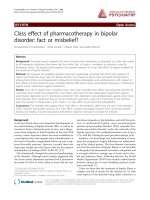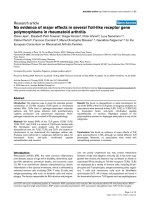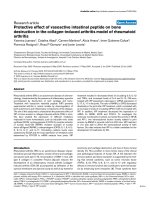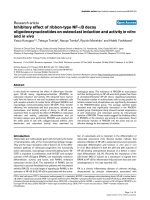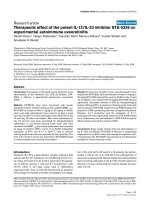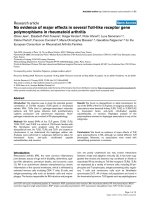Báo cáo y học: "No effect of omeprazole on pH of exhaled breath condensate in cough associated with gastro-oesophageal reflux" pdf
Bạn đang xem bản rút gọn của tài liệu. Xem và tải ngay bản đầy đủ của tài liệu tại đây (217.21 KB, 4 trang )
BioMed Central
Page 1 of 4
(page number not for citation purposes)
Cough
Open Access
Research
No effect of omeprazole on pH of exhaled breath condensate in
cough associated with gastro-oesophageal reflux
Alfonso Torrego*, Stefan Cimbollek, Mark Hew and Kian Fan Chung
Address: Department of Thoracic Medicine, National Heart & Lung Institute, Imperial College and Royal Brompton Hospital, London, UK
Email: Alfonso Torrego* - ; Stefan Cimbollek - ; Mark Hew - ;
Kian Fan Chung -
* Corresponding author
Abstract
Background: Endogenous airway acidification evaluated as pH in exhaled breath condensate
(EBC) has been described in patients with chronic cough. Proton pump inhibitors improve gastro-
oesophageal reflux (GOR)-associated cough.
Methods: We examined pH levels in EBC and capsaicin cough response in 13 patients with chronic
cough (mean age 41 years, SD 9) associated with GOR before and after omeprazole treatment (40
mg/day for 14 days) and its relationship with clinical response.
Results: Omeprazole abolished symptoms associated with GOR. Patients with chronic cough had
an EBC pH of 8.28 (SD 0.13) prior to treatment but this did not change with omeprazole treatment.
There was a significant improvement in the Leicester Cough Questionnaire symptom scores from
80.8 points (SD 13.2) to 95.1 (SD 17) (p = 0.02) and in a 6-point scale of cough scores, but there
was no change in capsaicin cough response.
Conclusion: An improvement in GOR-associated cough was not associated with changes in EBC
pH or capsaicin cough response. These parameters are not useful markers of therapeutic response.
Introduction
Chronic cough, conventionally defined as a cough persist-
ing for more than 8 weeks, is a common respiratory prob-
lem and, at times, presents as a difficult management
issue. Asthma, rhino-sinusitis and gastro-oesophageal
reflux (GOR) have been identified as the most common
diagnoses associated with chronic cough [1]. GOR alone
or in combination with other factors is the cause of
chronic cough in 10–40% of adult patients [2,3]. Two
main pathogenic mechanisms in GOR related cough have
been described: micro-aspiration of gastric contents and a
vagally-mediated oesophageal-tracheobronchial reflex
[4]. The acid content of the refluxate may be an important
component of the cough trigger associated with GOR, and
this is supported by the fact that the chronic cough in
some patients associated with GOR is improved or con-
trolled by proton pump inhibitors that suppress gastric
acid output [3,5,6]. Therefore, reflux of the gastric acid
could directly activate cough receptors in the upper air-
ways or indirectly through an oesophageal-tracheobron-
chial reflex [7].
Exhaled breath condensate (EBC) is a simple non-invasive
technique for the monitoring of airway inflammation,
since it may be representative of the epithelial lining fluid.
Endogenous airway acidification, as assessed by the pH of
Published: 19 October 2005
Cough 2005, 1:10 doi:10.1186/1745-9974-1-10
Received: 21 June 2005
Accepted: 19 October 2005
This article is available from: />© 2005 Torrego et al; licensee BioMed Central Ltd.
This is an Open Access article distributed under the terms of the Creative Commons Attribution License ( />),
which permits unrestricted use, distribution, and reproduction in any medium, provided the original work is properly cited.
Cough 2005, 1:10 />Page 2 of 4
(page number not for citation purposes)
exhaled breath condensate, has been reported in patients
with non-asthmatic chronic cough, including GOR [8].
The fall in pH represented a doubling in the amount of H
+
ions and this could contribute to the sensitised cough
reflex measured with capsaicin since an acid environment
has been shown to activate Aδ and C fibres in the airways
of rodents [7,9].
In order to examine further the significance of acid pH in
the pathogenesis of GOR-associated cough, we measured
pH of exhaled breath condensate in patients with chronic
cough associated with abnormal lower oesophageal pH.
We determined whether the improvement in cough asso-
ciated with treatment with proton pump inhibitors was
associated with changes in capsaicin responsiveness and
in EBC pH.
Methods
Subjects
We recruited 13 patients with chronic cough (age 41 ± 9,
5 males) defined as a cough persisting for more than 2
months, associated solely with GOR as defined by an
abnormal 24-hour oesophageal pH measurement from
our Cough Clinic. In these patients, we had excluded the
presence of asthma and rhino-sinusitis. FEV
1
(predicted
value: 99.8 ± 8.0%) and FVC (103 ± 8.0%) were within
the normal range. The chest radiograph was normal and
histamine responsiveness measured as PC
20
(the concen-
tration of histamine causing a 20% fall in FEV
1
) as greater
than 16 mg/ml. Skin prick to common allergens were neg-
ative and they had no nasal symptoms. Eight of 13
patients reported symptoms of heartburn, regurgitation or
dyspepsia; the rest were asymptomatic. All participants
were non-smokers. All subjects gave informed consent to
participate in the study which was approved by the Royal
Brompton and Harefield NHS Trust Ethics Committee.
Oesophageal pH study
An ambulatory 24 hour pH study was performed with the
Synectics Digitrapper Mk III (Synectics Medical A/B, Swe-
den). An Antimony pH electrode was placed just above
the upper border of the lower oesophageal sphincter. An
acid reflux episode was defined as a drop in pH below 4.0.
Significant reflux was defined as the total duration of
reflux episodes exceeding 3.4% of the total study time.
Symptom questionnaire
Cough severity was assessed using the Leicester Cough
Questionnaire [10]. This consist of 19 questions (scored
from 1 to 7 points each) relating to quality of life issues
associated with chronic cough. A higher score indicates
better health status and the range of the scale is from 19 to
133. Additionally, we used a 6-scale incremental cough
symptom score with 0 as being no cough and 5 being the
worst score for distressing cough most of the time [11].
Cough scores measured by the Leicester Cough Question-naire before and after 2 weeks of omeprazole treatmentFigure 1
Cough scores measured by the Leicester Cough Question-
naire before and after 2 weeks of omeprazole treatment. * p
= 0.02.
Cough reflex sensitivity to inhaled capsaicin measured as the concentration of capsaicin causing 5 or more coughs (C5) before and after omeprazole treatmentFigure 2
Cough reflex sensitivity to inhaled capsaicin measured as the
concentration of capsaicin causing 5 or more coughs (C5)
before and after omeprazole treatment.
50
75
100
125
Pre Post
omeprazole (40 mg/day x 14d)
*
Cough score
(Leicester questionnare)
-1
0
1
2
3
Pre Post
omeprazole (40 mg/day x 14d)
Capsaicin - log C5 (
P
M)
Cough 2005, 1:10 />Page 3 of 4
(page number not for citation purposes)
Capsaicin cough challenge
Capsaicin (8-methyl-N-vanillyl-6-nonenamide, 98%)
obtained from Sigma-Aldrich, Gillingham, UK, was dis-
pensed from a nebuliser chamber attached to a breath-
activated dosimeter (PK Morgan Ltd, Gillingham, Kent,
UK) set at driving pressure of 22 lbs/sq inch and a dosing
period of 1 second. As described previously by Lalloo
[12], the procedure started with the inhalation of 0.9%
sodium chloride, followed with doubling doses of capsa-
icin from 0.976 µM (dose number 1) until 500 µM (dose
number 10). The test was terminated when the subject
coughed 5 times or more. The concentration of capsaicin
causing 5 coughs or more (C5) was recorded.
Exhaled breath condensate collection
Exhaled breath condensate (EBC) was obtained non-inva-
sively by using a condenser (EcoScreen; Jaeger; Wurzburg,
Germany) that collected the nongaseous components of
the expiratory air. Subjects breathed tidally through a
mouthpiece and a two-way non-rebreathing valve, which
also served as a saliva trap. They were asked to breathe at
a normal frequency and tidal volume, wearing a nose clip,
for a period of 10 min. If subjects felt saliva in their
mouth, they were instructed to swallow it. The condensate
(at least 1 ml) was collected on ice at -20°C, and was
transferred to 15 ml Corning tubes. Measurement of pH
was performed following de-aeration with argon (350 ml/
min for 10 min), using a pH meter (Jenway 350 pH meter,
Spectronic Instruments, Leeds, UK).
Study design
EBC collection, spirometry and capsaicin challenge were
performed on the same day in this order. These measure-
ments were performed before and after treatment with
omeprazole (40 mg/day for 14 days)
Statistical analysis
Data were analysed using Graph-Prism version 3.0
(Graph-Pad Software, San Diego, CA, US). Data are
expressed as the mean ± SD. Differences between groups
were determined using the Mann-Whitney U test. Capsai-
cin C5 values were analysed as log
10
C5. All reported p val-
ues are two-tailed. A p value of less than 0.05 was
considered statistically significant.
Results
The 8 patients with symptoms of gastro-oesophageal
reflux reported disappearance of these symptoms. Using
the Leicester cough questionnaire, in which the patients
assessed their cough and related symptoms on a scale
from 19 to 133 points, the patients reported a partial but
significant symptomatic improvement after two weeks of
omeprazole treatment (80.8 ± 13.2 vs. 95.1 ± 17 points, p
= 0.02; Figure 1). Using the 6-point symptom score scale,
we also found a reduction in cough score from 3.3 ± 0.7
to 2.6 ± 0.8 (p = 0.01). However, cough reflex sensitivity
to capsaicin was not altered by omeprazole (log C5: 0.753
± 0.23 vs. 0.707 ± 0.2; NS; Figure 2). There was no signif-
icant correlation between changes in the cough sensitivity
reflex to inhaled capsaicin and the Leicester cough score.
The log C5 was significantly lower than that measured in
a cohort of 80 non-coughing normal volunteers (log C5:
1.83 ± 0.89; p < 0.0001), indicating that the coughers had
a sensitised cough reflex. The pH of EBC was 8.28 ± 0.1
and did not change after 2 weeks of omeprazole treatment
8.25 ± 0.1 (Fig 3). EBC pH did not correlate with symp-
toms or with log C5.
Discussion
After 2 weeks' treatment with omeprazole, we found a par-
tial but significant clinical improvement in cough severity
as assessed using the validated Leicester cough question-
naire. This was not accompanied by changes in capsaicin
cough response or by changes in pH of the exhaled breath
condensate. We conclude that these measurements do not
reflect the clinical response. Additionally, omeprazole
does not change the pH of exhaled breath condensate,
most likely a reflection of the lack of change in pH of the
epithelial lining fluid. This may also indicate that direct
reflux of gastric acid into the upper airway is an unlikely
explanation of GOR-associated cough.
pH values in exhaled breath condensate in patients before and after omeprazole treatmentFigure 3
pH values in exhaled breath condensate in patients before
and after omeprazole treatment. There was no effect of
omeprazole.
7.9
8.0
8.1
8.2
8.3
8.4
8.5
Pre Post
omeprazole (40 mg/day x 14d)
pH
Cough 2005, 1:10 />Page 4 of 4
(page number not for citation purposes)
GOR is a common associated cause of chronic cough and
treatment with gastric acid suppressing proton pump
inhibitors is often effective in controlling cough [3,5,6].
We ascertained the presence of GOR by performing 24-
hour lower oesophageal pH monitoring in 13 patients, in
whom only 8 had symptoms of GOR. Although the main
purpose of the study was to determine any change in pH
of the exhaled breath condensate, we did find a significant
improvement in cough severity after 14 days of treatment.
This indicates that the therapeutic response resulting from
suppression of GOR by proton pump inhibitors occurs
rapidly. In a recent open study by Poe and Kallay,
improvement in cough was observed in 16 of 42 patients
at 2 weeks and in 38 at 4 weeks [3]. Therefore, we might
have seen further improvement with prolonged treat-
ment. The short duration of treatment might be a limita-
tion of our study.
The baseline EBC pH value in our patients was not lower
than that previously published for healthy controls
[13,14]. However, in a previous study performed in our
department, Niimi et al [8] found that the mean EBC pH
of patients with cough due to GOR was significantly lower
(7.90) than in our present study. A possible explanation
for this discrepancy may due to the small number of
patients with GOR-associated cough included in Niimi's
work (n = 5) and the fact that one of the patients had an
uncharacteristically low pH. If this outlier were to be
excluded, the other 4 values would be in a similar range to
ours.
The pathophysiological mechanisms underlying GOR-
associated cough are not fully understood. Micro-aspira-
tion of oesophageal contents into the larynx and tracheo-
bronchial tree is one of the possible explanations [15].
Our study indicates that this is unlikely since suppression
of gastric acid by omeprazole did not alter the pH of
exhaled breath condensate. Yorulmaz et al, in a recently
published work, could not demonstrate a significant rela-
tionship between acid reflux episodes, pH variations in
the upper oesophageal segments and symptoms of laryn-
geal irritation such as cough [16].
We found that cough sensitivity to capsaicin was increased
when compared to a group of historical non-coughing
normal volunteers [17,18]. However, there was no effect
of omeprazole on capsaicin sensitivity, despite a signifi-
cant symptomatic improvement in cough, a finding that
has been previously reported [18]. In one report, where
capsaicin cough reflex improved after omeprazole, the
patients had more severe GOR symptoms including pos-
terior laryngitis and acid flooding of the oesophagus [17].
In conclusion, our results indicate that EBC pH measure-
ment is not a good tool in the follow-up of GOR-associ-
ated chronic cough during treatment with a proton pump
inhibitors. In GOR, episodes of micro-aspiration are short
and do not produce a persisting level of airway acidifica-
tion, which may be the reason why changes in EBC pH are
not detected.
Acknowledgements
We thank the Lung Function laboratory of the Royal Brompton Hospital for
the measurement of oesophageal pH.
References
1. Irwin RS, Curley FJ, French CL: Chronic cough: the spectrum and
frequency of causes, key components of the diagnostic eval-
uation, and outcome of specific therapy. Amer Rev Respir Dis
1990, 141:640-7.
2. Fontana GA, Pistolesi M: Cough. 3: chronic cough and gastro-
oesophageal reflux. Thorax 2003, 58:1092-5.
3. Poe RH, Kallay MC: Chronic cough and gastroesophageal
reflux disease: experience with specific therapy for diagnosis
and treatment. Chest 2003, 123:679-84.
4. Ing AJ, Ngu MC: Cough and gastro-oesophageal reflux. Lancet
1999, 353:944-6.
5. Ours TM, Kavuru MS, Schilz RJ, Richter JE: A prospective evalua-
tion of esophageal testing and a double-blind, randomized
study of omeprazole in a diagnostic and therapeutic algo-
rithm for chronic cough. Am J Gastroenterol 1999, 94:3131-8.
6. Kiljander TO, Salomaa ER, Hietanen EK, Terho EO: Chronic cough
and gastro-oesophageal reflux: a double-blind placebo-con-
trolled study with omeprazole. Eur Respir J 2000, 16:633-8.
7. Kollarik M, Undem BJ: Mechanisms of acid-induced activation of
airway afferent nerve fibres in guinea-pig. J Physiol 2002,
543:591-600.
8. Niimi A, Nguyen LT, Usmani O, Mann B, Chung KF: Reduced pH
and chloride levels in exhaled breath condensate of patients
with chronic cough. Thorax 2004, 59:608-12.
9. Fox AJ, Urban L, Barnes PJ, Dray A: Effects of casazepine against
capsaicin- and proton-evoked excitation of single airway c-
fibres and vagus nerve from the guinea-pig. Neurosci Lett 1995,
15:421-28.
10. Birring SS, Prudon B, Carr AJ, Singh SJ, Morgan MD, Pavord ID:
Development of a symptom specific health status measure
for patients with chronic cough: Leicester Cough Question-
naire (LCQ). Thorax 2003, 58:339-43.
11. Hsu JY, Stone RA, Logan Sinclair RB, Worsdell M, Busst CM, Chung
KF: Coughing frequency in patients with persistent cough:
assessment using a 24 hour ambulatory recorder. Eur Respir J
1994, 7:1246-53.
12. Lalloo UG, Fox AJ, Belvisi MB, Chung KF, Barnes PJ: Capsazepine
inhibits cough induced by capsaicin and citric acid but not by
hypertonic saline in guinea pigs. J Appl Physiol 1995, 79:1082-7.
13. Vaughan J, Ngamtrakulpanit L, Pajewski TN, Turner R, Nguyen TA,
Smith A, Urban P, Hom S, Gaston B, Hunt J: Exhaled breath con-
densate pH is a robust and reproducible assay of airway
acidity. Eur Respir J 2003, 22:889-94.
14. Kostikas K, Papatheodorou G, Ganas K, Psathakis K, Panagou P,
Loukides S: pH in expired breath condensate of patients with
inflammatory airway diseases. Am J Respir Crit Care Med 2002,
15:1364-70.
15. Jack CI, Calverley PM, Donnelly RJ, Tran J, Russell G, Hind CR, Evans
CC: Simultaneous tracheal and oesophageal pH measure-
ments in asthmatic patients with gastroesophageal reflux.
Thorax 1995, 50:201-4.
16. Yorulmaz I, Ozlugedik S, Kucuk B: Gastroesophageal reflux dis-
ease: symptoms versus pH monitoring results. Otolaryngol
Head Neck Surg 2003, 129:582-6.
17. Benini L, Ferrari M, Sembenini C, Olivieri M, Micciolo R, Zuccali V,
Bulighin GM, Fiorino F, Ederle A, Cascio VL, Vantini I: Cough
threshold in reflux oesophagitis: influence of acid and of
laryngeal and oesophageal damage. Gut 2000, 46:762-7.
18. Nieto L, de Diego A, Perpina M, Compte L, Garrigues V, Martinez E,
Ponce J: Cough reflex testing with inhaled capsaicin in the
study of chronic cough. Respir Med 2003, 97:393-400.



